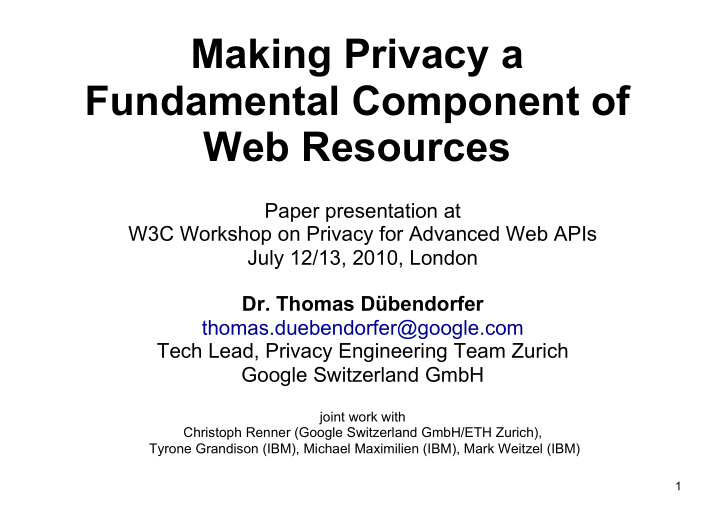



Making Privacy a Fundamental Component of Web Resources Paper presentation at W3C Workshop on Privacy for Advanced Web APIs July 12/13, 2010, London Dr. Thomas Dübendorfer thomas.duebendorfer@google.com Tech Lead, Privacy Engineering Team Zurich Google Switzerland GmbH joint work with Christoph Renner (Google Switzerland GmbH/ETH Zurich), Tyrone Grandison (IBM), Michael Maximilien (IBM), Mark Weitzel (IBM) 1
Picture sharing in social networks You better know who you share your pictures with! image source: http://thebsreport.files.wordpress.com/2009/12/crazy-drunk-man-1.jpg 2
How to improve privacy? • Better transparency on how personal data is shared on the Web • More control over how personal data is shared on the Web • Put the right security building blocks in place to build privacy features on top of them 3
Photo albums privacy levels in social networks (as of Nov 2009) Conclusion: Sharing granularities in social networks differ a lot! Everybody = any Internet user, also outside the social network All Users = any user of the social network 4
APIs to access photo album privacy settings in social networks Controlling who has access to my images • Facebook : Proprietary API for privacy settings • MySpace : Proprietary API extensions for albums • OpenSocial API (36 social networks, e.g. Orkut, MySpace, LinkedIn, hi5, XING): No API to access privacy settings up to current version 1.0 (March 2010); „default“ sharing for uploads Clear need for a standardized way to access privacy settings across social networks! 5
How to give the user control over his personal data on the web? • Define generic access control lists for shared Web resources • Make them available in APIs • Add privacy controls to user interfaces of apps uploading personal data to the Web • Feb 28th, 2010: Proposal for privacy API (generic access control lists) submitted for inclusion in OpenSocial 1.1. 6
Generic Access Control Lists – some challenges and features • Entities – Finding the balance between too few and too many while keeping it extensible (CUSTOM) and simple • OpenSocial: – USER, GROUP, EXTERNAL CONTACT – Group-ID = Object-Id / "@self" (for owner) / "@friends” (networkDistance for friends of friends) / "@all" / "@everybody" / "@family” – External Contact AccessorId = "MAILTO" / "PHONE" / Custom-Accessor-Type Custom-Accessor-Type = LOALPHA TEXT 7
Generic Access Control Lists – some challenges and features • Rights – How to define appropriate rights that can be enforced • OpenSocial RESTful API: [“GET”, “POST”, “PUT”, “DELETE”] • Sharing model – Additive (whitelist) vs. Subtractive (all but blacklist) or a combination – Issues with hidden memberships in large groups – Issues with hidden data item groupings (user profile) 8
Generic Access Control Lists – some challenges and features • Sharing with open membership groups – You share with 10 known group members today, but 1000 members tomorrow (including your boss?) – Social networks might not want to share member lists • Privacy indicator – Number of people with read access • Inheritance of rights – Photo album ACL can be overriden by single image ACLs 9
Proof of Concept • Generic access control lists implemented in Google’s social network “Orkut” • Photo Sharing application “Photocial” for Android – Upload your picture to multiple social networks – User can control the privacy level per social network when uploading images 10
Beyond Social Networks • The Web becomes more and more social – why not attach ACLs to any personal Web resource? • Issues: – ACLs require an accessing entity to be identified; could build on federation of social network identities – ACLs work only if trusted systems enforce them (server and/or client side) – Digital data without copy protection can be redistributed without ACLs (violation “scanner” for enforcement?) 11
Next Steps • Implementation of proposed OpenSocial ACLs in Apache Shindig • Work towards inclusion of generic ACLs in OpenSocial 1.1Next (Q1 2011) 12
Thanks for your attention Presenter: Thomas Dübendorfer, Google Switzerland GmbH References: • Proposal for OpenSocial Privacy API (ACLs): http://tinyurl.com/OSACL (includes also references to our proposals for an OpenSocial Album and MediaItem Privacy API and an OpenSocial Activity Privacy API) • Paper: http://www.w3.org/2010/api-privacy-ws/ papers/privacy-ws-26.pdf 13
Recommend
More recommend